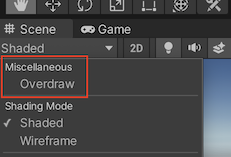It's scene overdraw view available in Universal Render Pipeline. It works not only in the Scene view, but also in the Game view and in the app after it has been built.
Unity official support for overdraw began in URP12 (Unity2021.2) with a feature RenderingDebugger.
To install via upm, specify https://github.com/ina-amagami/OverdrawForURP.git.
{
"dependencies": {
"jp.amagamina.overdraw-for-urp": "https://github.com/ina-amagami/OverdrawForURP.git"
}
}- Add "OverdrawRenderer" to the list of General > RendererList in the UniversalsRenderPipelineAsset. If you don't see "OverdrawRenderer" in the list of selections when you add it, press the eye symbol on the right side of the window to show it.
- Add
USE_RUNTIME_OVERDRAWto Scripting Define Symbols if you want to use it in your app after building it. Here is a gist of an example script that shows how to Overdraw the main camera.
In the upper left corner of the Scene view, if you click on the button that is normally labeled "Shaded", an "Overdraw" item will be added, which you can enable by clicking here. If you want to bring it back, click on "Shaded".
In the Built-in pipeline, all objects are treated as transparent, but this makes it look as if all the pixels are overdraw. Therefore, used ZTest for opaque objects.
If you want to disable ZTest, you can change "Opaque Shader" to "Overdraw-Transparent" in the "OverdrawRenderer" asset settings as shown below.
If you installed it from upm, you can't change it, so create a new "ForwardRenderer" asset and adjust the settings. the "Name" section must be "OverdrawRendererFeature".
Overdraw is accomplished by changing the default renderer.
The target pipeline assets cannot be saved while using Overdraw. When updating render pipeline asset, please turn off Overdraw before saving.
- Unity 2019.4.8f1 / URP 7.4.3
- Unity 2020.1.3f1 / URP 8.2.0
- Unity 2020.3.2f1 / URP 10.4.0
This software is released under the MIT License. https://opensource.org/licenses/mit-license.php
Copyright (c) 2020 ina-amagami (ina@amagamina.jp)



